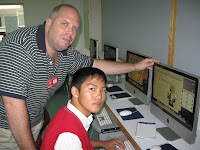 We live in an information age and preparing students for life in a technological world is an essential part of their education at TIS. Mark Harrison plays a key role in that preparation as the school’s secondary computer teacher.
We live in an information age and preparing students for life in a technological world is an essential part of their education at TIS. Mark Harrison plays a key role in that preparation as the school’s secondary computer teacher.“Technology is a part of our lives and will just continue to grow. Learning about technology allows students to be active and participating members of the global community.”, he says.
The secondary computer program consists of two different curricula. Students in grades 7 to 9 participate in the ICT or “Information and Communication Technology” program, while students in grades 10 to 12 take the CTS or “Career and Technology Studies” program.
ICT classes teach students the basics about different technologies such as computers, cameras, projectors, interactive whiteboards, scanners, printers as well as different types of software. Students are assigned projects that not only require them to apply what they’ve learned, but that also support core subject areas. Last year for example, grade eight ICT students designed and produced a tri-fold travel brochure about Japan, a country they were also studying as part of a social studies unit.
The more advanced CTS classes enable students to further their knowledge of various technologies and software. They choose areas of study or “strands” from a range of topics including communication technologies, design studies, enterprise and innovation, financial management, information processing, and management and marketing. The program is self-guided and students take responsibility for their own learning under the guidance of Mr. Harrison. “This type of learning teaches students discipline. It also teaches them that if they want something, they have to work for it and do it for themselves.”, he says.
The secondary computer program consists of two different curricula. Students in grades 7 to 9 participate in the ICT or “Information and Communication Technology” program, while students in grades 10 to 12 take the CTS or “Career and Technology Studies” program.
ICT classes teach students the basics about different technologies such as computers, cameras, projectors, interactive whiteboards, scanners, printers as well as different types of software. Students are assigned projects that not only require them to apply what they’ve learned, but that also support core subject areas. Last year for example, grade eight ICT students designed and produced a tri-fold travel brochure about Japan, a country they were also studying as part of a social studies unit.
The more advanced CTS classes enable students to further their knowledge of various technologies and software. They choose areas of study or “strands” from a range of topics including communication technologies, design studies, enterprise and innovation, financial management, information processing, and management and marketing. The program is self-guided and students take responsibility for their own learning under the guidance of Mr. Harrison. “This type of learning teaches students discipline. It also teaches them that if they want something, they have to work for it and do it for themselves.”, he says.
No comments:
Post a Comment